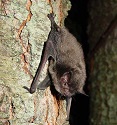 The Indiana bat was first listed as endangered in 1967, under the precursor to the Endangered Species Act due to population declines associated with disturbance during hibernation and changes to the hibernacula. However, protection of hibernacula (caves and mines) solely did not lead to species recovery. Consequently, bat biologists began to focus on other habitat needs, including summer maternity habitat. During the summer months, Indiana bat maternity colonies roost under the exfoliating bark of large dead and/or dying trees.
The Indiana bat was first listed as endangered in 1967, under the precursor to the Endangered Species Act due to population declines associated with disturbance during hibernation and changes to the hibernacula. However, protection of hibernacula (caves and mines) solely did not lead to species recovery. Consequently, bat biologists began to focus on other habitat needs, including summer maternity habitat. During the summer months, Indiana bat maternity colonies roost under the exfoliating bark of large dead and/or dying trees.
In 2004, a previously documented Indiana bat maternity colony was relocated near Cundiff Lake at the Fort Knox Military Installation in Kentucky. Fort Knox designated this area as its “Indiana Bat Management Area” (IBMA) to provide protection to the bats. In order to better manage for this species, Mike Brandenburg, Fort Knox’s Wildlife Program Manager wanted to learn more about the Fort Knox colony and began working with the USFWS Kentucky Field Office (KFO) and Copperhead Environmental Consulting, Inc. to monitor it. Over the following years, these partners learned much about the colony’s use of Fort Knox and discovered two additional maternity colonies. The challenge became finding a way to both protect the maternity colonies and support the Army’s mission.
 |
|
| Installed Roosts. Photo credit: Copperhead Environmental Consulting, Inc |
The main concern was that the natural roosts used by the colony had started to deteriorate with age. We were concerned the bats would leave the IBMA and move to other, unprotected areas on Fort Knox. One of the first ideas was to test artificial roosts, hoping that this would be a way to keep the bats within the protected area of the IBMA. Real bark, environmentally friendly roofing shingle (Eco-Shake), and fiberglass artificial bark were tested. The most promising material was a polymer-based artificial bark, used by zoos and theme-parks. After modifying the bark so bats could grip it, BrandenBark™ (named for Mike) was coined and the bats flew to it!
The partners have continued working together evaluating the effectiveness of using artificial bark such as BrandenBark™ for Indiana bats. To date, BrandenBark roosts have been installed in 8 states and 1 Canadian province. BrandenBark™ roosts provide several advantages over natural roosts: they are easily monitored, they withstand the elements and last longer, and they immediately provide habitat when installed. There was even an emergence count that recorded over 450 bats in one structure, and regularly more than 150 using multiple structures in any given year at Fort Knox. With the natural degradation of habitat at Cundiff Lake, the Indiana bats in that colony could shift their colony away from the IBMA to unprotected areas. Installation of BrandenBark™ structures have provided suitable roosting habitat in the IBMA for the Indiana bats and allowed its continued use… a true success story!
Mike Armstrong is a biologist at the U.S. Fish and Wildlife Service’s Kentucky Ecological Services Office and can be reached at Mike_Armstrong@fws.gov
